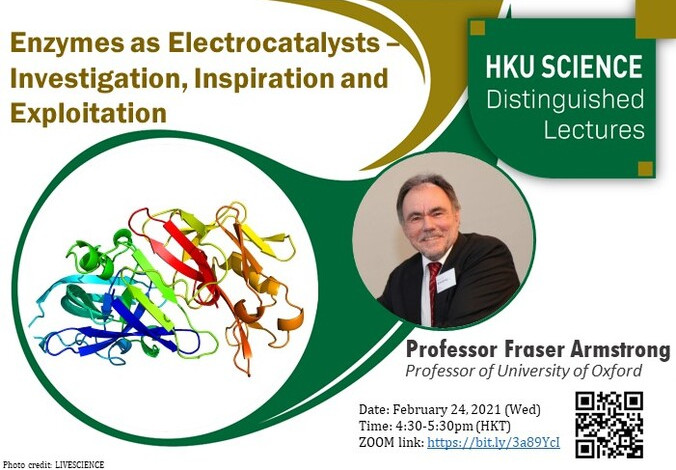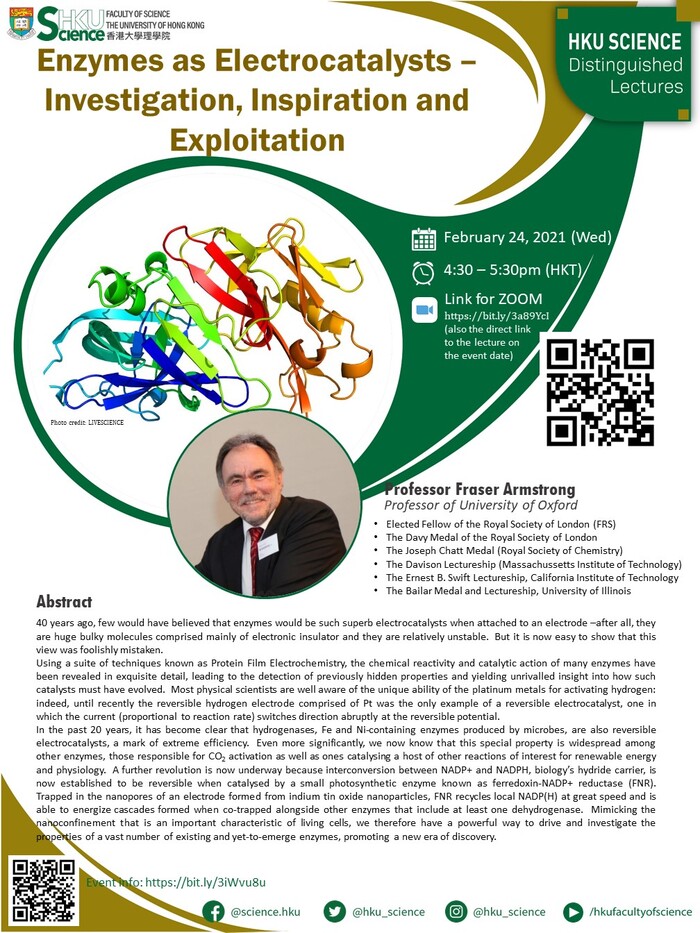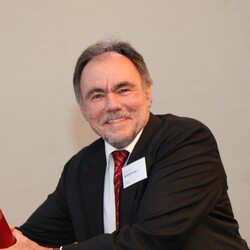Distinguished Lecture - Enzymes as Electrocatalysts – Investigation, Inspiration and Exploitation

- Date & Time
- February 24, 2021 (Wed) | 4:40-5:30pm (HKT)
- Venue
- ZOOM online lecture (https://bit.ly/3a89YcI)
- Speaker
- Professor Fraser Armstrong
Professor of University of Oxford

40 years ago, few would have believed that enzymes would be such superb electrocatalysts when attached to an electrode –after all, they are huge bulky molecules comprised mainly of electronic insulator and they are relatively unstable. But it is now easy to show that this view was foolishly mistaken.
Using a suite of techniques known as Protein Film Electrochemistry, the chemical reactivity and catalytic action of many enzymes have been revealed in exquisite detail, leading to the detection of previously hidden properties and yielding unrivalled insight into how such catalysts must have evolved. Most physical scientists are well aware of the unique ability of the platinum metals for activating hydrogen: indeed, until recently the reversible hydrogen electrode comprised of Pt was the only example of a reversible electrocatalyst, one in which the current (proportional to reaction rate) switches direction abruptly at the reversible potential.
In the past 20 years, it has become clear that hydrogenases, Fe and Ni-containing enzymes produced by microbes, are also reversible electrocatalysts, a mark of extreme efficiency. Even more significantly, we now know that this special property is widespread among other enzymes, those responsible for CO2 activation as well as ones catalysing a host of other reactions of interest for renewable energy and physiology. A further revolution is now underway because interconversion between NADP+ and NADPH, biology’s hydride carrier, is now established to be reversible when catalysed by a small photosynthetic enzyme known as ferredoxin-NADP+ reductase (FNR). Trapped in the nanopores of an electrode formed from indium tin oxide nanoparticles, FNR recycles local NADP(H) at great speed and is able to energize cascades formed when co-trapped alongside other enzymes that include at least one dehydrogenase. Mimicking the nanoconfinement that is an important characteristic of living cells, we therefore have a powerful way to drive and investigate the properties of a vast number of existing and yet-to-emerge enzymes, promoting a new era of discovery.
Playback video:

Speaker Professor Fraser Armstrong
Professor of University of Oxford
Summary of career: Fraser Armstrong is a Professor of Chemistry at Oxford University and a Fellow of St John’s College. He obtained his PhD at University of Leeds with Geoff Sykes then carried out postdoctoral research with Peter Kroneck (Konstanz), Ralph Wilkins (New Mexico), Helmut Beinert (Madison) and Allen Hill (Oxford). In 1983 he was awarded a Royal Society University Research Fellowship which he held in Oxford until 1989 when he joined the Chemistry Faculty at the University of California, Irvine, obtaining tenure in 1992. He moved to his present position in Oxford in 1993. In 2008, he was elected a Fellow of the Royal Society of London. He was honored at that time for pioneering the application of dynamic electrochemical techniques to the study of enzyme mechanism and biological electron transfer. Protein film electrochemistry has resulted in the resolution of previously intractable reactions of active sites, the identification of many enzymes as reversible electrocatalysts and exemplars for renewable energy technologies, the visualization and role of long-range coupling of electron and proton transfer in catalysis, and most recently a powerful new way to energize, control and investigate enzyme cascades confined in nanospace. His efforts are providing insight into the design of optimal electrocatalysts for the future, both in detail and horizon (almost perfect catalysts do exist and they are products of evolution). Awards and Honours 1978 Royal Society European Exchange Fellowship, held in Konstanz, Germany 1983 Royal Society University Research Fellowship (until 1989) 1998 European Medal for Biological Inorganic Chemistry 2000 Royal Society of Chemistry Award for Inorganic Biochemistry. 2003 The Carbon Trust Academic Innovation Award. 2004 Max-Planck ‘Frontiers in Biological Chemistry’ Award. 2006 Royal Society of Chemistry Medal for Interdisciplinary Chemistry. 2008 Elected Fellow of the Royal Society of London (FRS). 2009 The Lewis Lectureship, University of Cambridge 2010 The Joseph Chatt Medal (Royal Society of Chemistry) 2011 The Davison Lectureship (Massachussetts Institute of Technology) 2012 The Barker Medal (Royal Society of Chemistry Electrochemistry Group) 2012 The Davy Medal of the Royal Society of London 2013-2018 Wolfson Research Award 2014 The Ernest B. Swift Lectureship, California Institute of Technology 2015 The Hutchison Lectureship, University of Rochester 2015 The Bailar Medal and Lectureship, University of Illinois 2020 The Glenn T. Seaborg Lectureship, University of California, Berkeley (postponed)

